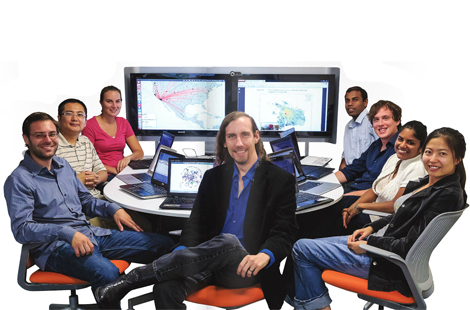Joining forces

Joining forces
- December 3, 2012
- Center for Networks and Relational Analysis, headed by sociologist Carter Butts, fosters interdisciplinary research
 Not so long ago, the word ‘network’ brought to mind electrical engineers hunched over
silicon chips.
Not so long ago, the word ‘network’ brought to mind electrical engineers hunched over
silicon chips.
Today, networks encompass sociology, biology, communications, public health, criminology and a myriad of other realms.
Researchers looking to unravel overlapping connections can find support at the Center for Networks and Relational Analysis, housed in the Calit2 Building.
Led by Carter Butts, a UCI sociology and statistics professor, the center provides neutral territory where sociologists, electrical engineers, computer scientists, chemists, psychologists, statisticians, public health experts and criminologists can hang their hats while they work together on network-related issues that transcend any one field.
“In all of these cases, we’re dealing with complex datasets, complex analytical methods and substantive domains that vary widely,” says Butts, who became convinced “that the way to move forward was not just through the social scientists who study social networks but [through] a much broader program to bring together people who look at networks from a variety of different standpoints and domains.”
Cynthia Lakon, a health sciences assistant professor, is examining the connection between adolescent social networks and substance abuse.
“This center is a terrific academic home for me and my research,” she says. “Being part of the center provides me with a way to connect with colleagues across disciplines, and has brought an interdisciplinary dimension to my work that has been very beneficial.”
Butts and his research team, who operate under the mantle of the Networks, Computation and Social Dynamics lab, manage several different projects. One, which includes UCI criminologist John Hipp and a University of Tennessee geographer, is analyzing a large-scale survey of social networks in the Western United States. Dubbed the American Social Fabric Project, it examines ties between family members, social acquaintances, employers, confidantes and others in multiple communities. The social networks that emerge yield important practical information, like the best way to communicate with a particular community and how to predict crime rates more accurately.
“We’re trying to understand the large-scale structure of human social relationships,” Butts says. “In many cases, what goes on locally is affected by the social fabric of the area.”
Another signature project, named HEROIC – Hazards, Emergency Response and Online Informal Communication – investigates the role of microblogging and other informal online communication tools in disseminating information after a disaster.
“If you want to get situational awareness about a rapidly unfolding event, being able to tap into what’s going on in the social media is very important,” according to Butts. “That’s a huge resource that emergency managers can use.”
Electrical engineering and computer science associate professor Athina Markopolou has collaborated on several multidisciplinary projects. Recently, she and Butts partnered to sample online social networks, an effort she says was an “extremely productive collaboration that got a lot of visibility. It also inspired several other directions in our respective groups.”
Currently, she and Butts are collaborating with computer scientist Natasa Przulj. The three are leveraging developments in computer, social and biological networks to create an integrated, interdisciplinary approach to the study of systems with complex network structures.
Ongoing computational advances have created a rapidly changing research environment that makes the Center for Networks and Relational Analysis an important research partner, according to Butts.
“We have this computer science-statistical-mathematical-IT wave of innovation that has happened hand-in-hand with substantive advances in specific disciplines,” he states. “You need all of this [different] information to get the science done. And that’s not something you can do from one disciplinary point of view.”
“You have to foster connections across groups and across disciplines to combine knowledge in a way that’s going to lead to the next generation of scientific and technical advances.”
-Calit2 Communications
-pictured: Butts (center) and his multidisciplinary team work on network-related
issues that transcend any one field.
Share on:




connect with us